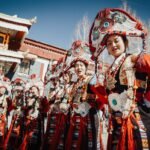Jewellery
Tibetan ornaments, such as dzi beads, agate, turquoise, coral, ox bone products, Tibetan silver, and Tibetan copper, vary in price and quality. However, the value of a gift is not solely determined by its price. Tibetan ornaments often incorporate materials and patterns that symbolize good fortune. For instance, a simple Tibetan silver bracelet with Sanskrit engravings can serve as a prayer for blessings. The prized Tibetan dzi beads, particularly the “one-eyed dzi beads,” symbolize wisdom, while the “double-eyed dzi beads” can bring marital harmony.
Tibetan incense
Tibetan incense is crafted with valuable Tibetan medicines and herbs like saffron, snow lotus, Rhodiola rosea, and agarwood. Its production embodies Tibetan culture and makes for a great tourist memento. Tibetan incense boasts a luxurious fragrance that not only imbues clothes with a pleasant scent but also repels insects. Certain variants of Tibetan incense, enriched with unique elements, possess the ability to prevent and alleviate infectious diseases. We highly recommend Tibetan incense as the optimal choice for the elderly and devout Buddhists.
Tibetan knives
Tibetans in pastoral areas must have Tibetan knives. These knives serve multiple purposes such as eating meat, protecting the body, and as ornaments. Men’s Tibetan knives are rough and exquisite, while women’s knives are delicate. The most renowned Tibetan knives are the “Lhatse Knife” and “Xietongmen Knife” from the Shigatse region, with prices ranging mostly between two and three digits.
Tibetan medicine
Tibet is renowned for its sacred mountains and holy water, which have made Tibetan medicinal materials famous worldwide. These include Ganoderma lucidum, saffron, Cordyceps, snow lotus, and more. While these materials are highly valuable, We advise caution when purchasing them. Considering their impact on the body, it is advisable to obtain them from authorized pharmacies and sales offices.
Tibetan Carpets / Rug
In a Tibetan house, there is an appealing cushion adorned with exquisite embroideries. These include swimming dragons, running deer, flying phoenixes, butterflies, mountains, and waters. Some cushions may even feature historic stories and tales. A stunning cushion can enhance the magnificence of a house. Made from pure sheep wool, these cushions are hand-knitted and coloured with local pigments, resulting in vibrant hues. The patterns of Tibetan cushions are unique and diverse.
In addition to Tibetan cushions, there are various types of Tibetan carpets, such as backing, saddle, sleeping, and regular carpets. These carpets are made using similar production methods. Their sizes range from less than one square meter to over ten square meters. Tibetan carpets have a rich history and are renowned globally. They are intricately crafted, showcasing the ingenuity of the Tibetan people. These crafts are a harmonious blend of functionality and allure.
Masks
Tibetan sculpture includes a unique form of handicraft known as masks, referred to as “Ba” in Tibetan. These masks are primarily used in folk performances. They can be categorized as “deity worship masks,” “hanging masks,” and “Tibetan opera masks.” The masks used in important festivals represent ghosts, gods, immortals, and animal totems. On the other hand, hanging masks are associated with daily life.
According to historical records, the use of masks traces back to A.D. 779 during the rule of King Songtsen Gampo in Tibet. During significant festivals, people would wear different masks and partake in dances, representing lions, tigers, oxen, and leopards. Tibetan masks are characterized by their expressive and symbolic nature, often portraying exaggerated features. The styles of masks vary across different regions of Tibet, with masks in central Tibet being serious and those in the eastern part being monstrous.
Thangka
Thangka is a popular art form in Tibetan painting, akin to scroll painting in other parts of China. Its origins have been debated, with some suggesting a connection to Chinese scroll painting, while others believe it stems from painting traditions in India and Nepal. Thangka comes in various sizes, ranging from over ten square meters to smaller than one square meter. Typically, its size falls between one and two square meters. Additionally, Thangka can be categorized into three types: embroidery, painting, and printing.
Silver ornaments
Tibetan bracelets are typically crafted from Tibetan silver and bronze, and adorned with Sanskrit carvings that exude a sense of primitive simplicity and mystique. Tibetans adorn themselves with crescent-shaped silver ornaments, symbolizing purity, embellished with agate gems representing health and good fortune. Red or blue Tibetan ornaments indicate the wearer’s strong determination to thrive amidst nature. Genuine Tibetan ornaments feature a grain on the backside, created by melting brass wires onto them, rather than being carved or printed.
Trinkets
Tibet is special due to its distinct geography, ethnic traits, and religious ambience. Examples include prayer wheels, prayer flags, curtains, keychains, and Tibetan dolls. It would be truly unique to capture photos of the trip, accompanied by Tibetan dolls, amidst the sacred mountains and lakes.
Postcard
Postcards are a common travel gift, requiring minimal cost and effort. Tibet offers a variety of Tibetan-style postcards, allowing you to select ones that match your friends’ characteristics. For instance, you can send a duck postcard to a friend called Duck, along with the message “When I came here, I thought of you.” This may be a sentimental gesture, but it conveys the postcard’s most beautiful meaning.
Tips:
Traditional handicrafts from Tibet, such as carpets, knives, rugs, aprons, costumes, shoes, caps, and gold and silver ornaments, are created by skilled artisans. Bakhor Street in Lhasa, renowned for being a hub of small commodities, holds great historical and religious significance. It is highly recommended to dedicate time to exploring this ancient and sacred place. Don’t forget to negotiate prices when purchasing souvenirs.
Purchasing wild animal furs, Procapra horns, or wild yak skulls from Tibet may lead to trouble as these items are illegally obtained by poachers.



















